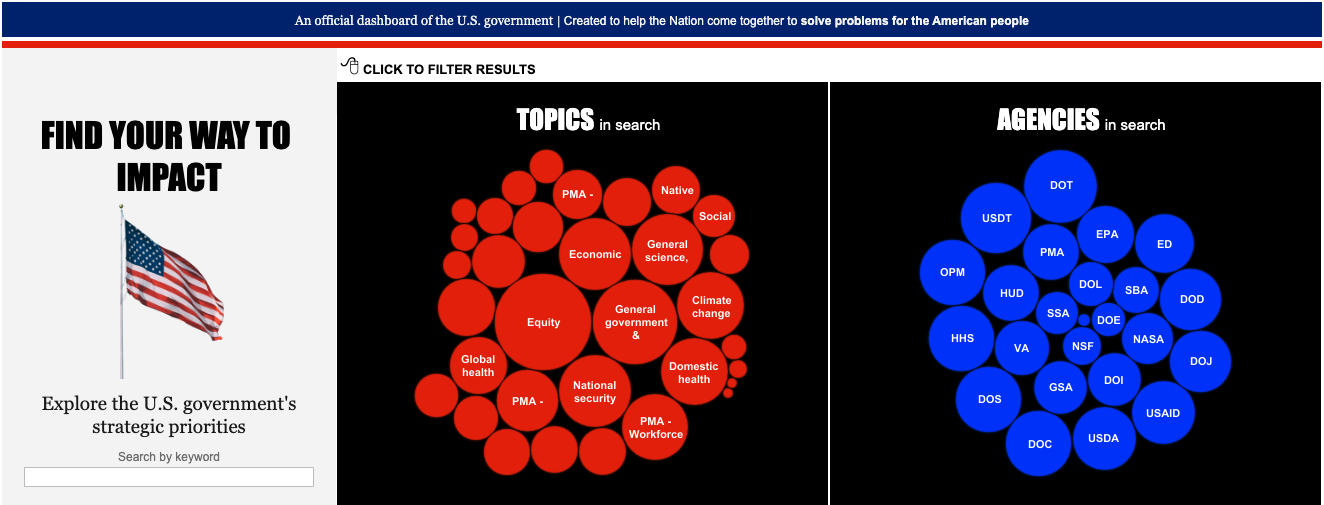Every two years, federal agencies set priority goals to organize their management activities and apply their available resources to improve our day to day lives. Agency Priority Goals, or APGs, reflect the top implementation-focused priorities of agency leadership and the Administration’s ambitious but achievable performance targets and milestones in an agency’s strategic plan that support improvements in near-term outcomes, customer experience, or efficiencies. When an APG is set, it considers numerous factors and principles. Does the goal align with the mission and longer-term strategic objectives within the agency? Is there enough available data to measure success throughout the two-year term?
The Performance.gov team sat down with five Agency Priority Goal leaders to hear about the progress they made during the FY 2022-23 goal cycle and reporting period. The work of these leaders and their agency goal teams spanned a range of priority efforts, from bridging the digital divide, to enhancing healthcare access, and supporting small businesses. Each day, these leaders are spearheading initiatives that affect the livelihoods of millions.
USDA and DOC Bridging the Gap with Affordable High-Speed Internet Access
Americans, along with the rest of the world, rely on the internet daily. Access to fast and affordable internet is crucial for various industries throughout the U.S., including farming, manufacturing, and mining. In rural areas, internet access makes it easier for people to communicate, receive online education, and even access medical help. Andrew Berke, Administrator of the Rural Utilities Service at the U.S. Department of Agriculture (USDA), shared with us how the USDA and Department of Commerce (DOC) are working together to provide all Americans with universal access to affordable, reliable high-speed internet, including those in rural areas.
Learn more about investments in rural broadband on USDA.gov. Read updates from the FY 2022-23 goal cycle on Performance.gov.
Advancing Equity in Behavioral Health Services: HHS Enhancing Access and Outcomes
Many resources exist for those struggling with mental health and substance abuse in the U.S. However, closing the gap between those in need of services and those accessing them can be challenging and takes concerted effort. Performance.gov sat down with goal leaders Dr. Miriam Delphin-Rittmon, Assistant Secretary for Mental Health and Substance Use, Substance Abuse and Mental Health Services Administration (HHS), and Dr. Debra Houry, Acting Principal Deputy Director, Centers for Disease Control and Prevention (HHS), on increasing equitable access to and utilization of prevention, treatment, and recovery services to improve health outcomes for those affected by behavioral health conditions.
To learn more about the SAMHSA program, visit SAMHSA.gov. For updates on the FY 2022-23 goal cycle, refer to Performance.gov.
If you or a loved one needs help, visit SAMHSA’s National Helpline, also known as the Treatment Referral Routing Service, at 1-800-662-HELP (4357). You can also reach out to TTY at 1-800-487-4889. This service is confidential, free, and available 24/7, 365 days a year. It provides information and support in English and Spanish for individuals and family members facing mental and/or substance use disorders.
VA’s Commitment to Enhancing Caregiver Assistance Programs
The Department of Veterans Affairs (VA) is dedicated to supporting caregivers and Veterans alike. Performance.gov sat down with Tim Jobin, Deputy Director, Caregiver Support Program at the U.S. Department of Veteran Affairs , who shared how the VA set a goal to expand access to and improve the Caregiver Support Program. This program offers clinical services to caregivers of eligible and covered Veterans enrolled in the VA health care system.
Learn more about the Caregiver Support Program at caregiver.va.gov. Read updates from the FY 2022-23 goal cycle on Performance.gov.
SBA’s Mission to Expand Financial Resources in Underserved Markets
Small businesses drive innovation and job growth in the U.S. However, in certain markets, access to essential financial resources remains unequal. Performance.gov sat down with John Miller, Deputy Associate Administrator at the Office of Capital Access, Small Business Administration (SBA). He discussed how the SBA set a goal to increase access to capital in underserved markets by connecting small business owners with more community financial institutions (CFIs).
To learn more about the Lender Match program, visit SBA.gov. Read updates from the FY 2022-23 goal cycle on Performance.gov.
Learn More
How can I search for updates and/or goals on topics that are important to me?
The Strategic Goal Dashboard on Performance.gov makes it easy to filter by agency and topic to explore overviews and updates on what the Federal Government achieves for the American people.

Stay Informed
Follow along with Performance.gov on LinkedIn and Twitter (X) as we highlight different agencies and their goals. We will continue to update Performance.gov quarterly with progress on agency and PMA priorities and strategies. Subscribe to our newsletter to receive updates in your inbox.




